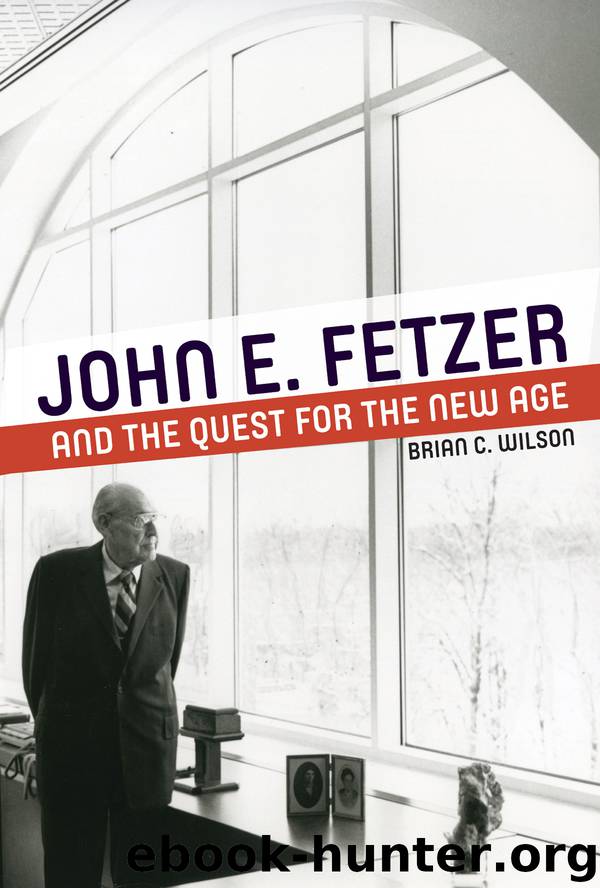John E. Fetzer and the Quest for the New Age by Brian C. Wilson

Author:Brian C. Wilson
Language: eng
Format: epub
Publisher: Wayne State University Press
25. Channeled diagram of Fetzer Foundation mission.
Funded Research under the New Mission
To some extent, the new mission did not entail a complete shift of the foundation’s funding activities since some of the previous projects easily fit within it. These included William’s Holistic Health Program at WMU and Hardt’s biofeedback studies (which continued to receive Fetzer funding until 1985).13 Another such project that received funding before the new mission was approved was that of Herbert Benson from Harvard. One of the pioneers of mind/body medicine, Benson had done work on Transcendental Meditation, which formed the basis for his best-selling 1975 book The Relaxation Response.14 Fetzer contacted Benson after reading about The Relaxation Response, and this eventually led to an invitation to speak at Kalamazoo College in 1980 as part of a Fetzer-funded lecture series.15 Soon after, Benson wrote to Fetzer requesting financial assistance for a new project that he and his team were planning involving Tibetan Buddhist monks. Through his contact with the Dalai Lama, Benson had gained access to monks who practiced g Tum-mo yoga, or heat yoga, which allowed them to raise their body temperatures at will, supposedly by drawing in prana (subtle energy) from the “inexhaustible ‘pranic’ reservoir of Nature.” The rise in body temperature, it was reported, was enough to dry sheets doused with ice water. Due in part to Fetzer support, Benson and his team were able to travel back to Dharamsala, India, to study and film this meditation practice, the results of which were published in Nature.16 John Fetzer was thrilled by this research, as it confirmed his confidence in Life and Teachings of the Masters of the Far East, commenting, “finally what Spalding said is being done.”17 Further funding followed, this time to underwrite a trip to China to investigate the work of Qi Gong masters in that country.18 Benson’s work continued to receive foundation support until 1991.19
Another project during this period was related in many ways to Benson’s work with Tibetan monks. This was the work of Elmer Green at the Menninger Foundation, who was brought to the attention of the Fetzer Foundation by WMU’s Richard Williams, whose mentor Green was.20 Green was a pioneer in the field of biofeedback and was one of the first to study this phenomenon in yogis and other spiritual adepts. In the 1980s, Green, who was fascinated by Spiritualist and Theosophical literature, was inspired by comments about meditation practices in the Theosophical classic The Mahatma Letters to A. P. Sinnett (1924). According to the words of Master Kuthumi recorded in that book,
The methods used for developing lucidity in our chelas (student monks) may be easily used by you. Every temple has a dark room, the north wall of which is entirely covered with a sheet of mixed metal, chiefly copper, very highly polished, with a surface capable of reflecting in it things as well as a mirror. The chela sits on an insulated stool, a three-legged bench placed in a flat-bottomed vessel of thick glass,—the lama operator likewise, the two forming with the mirror wall a triangle.
Download
This site does not store any files on its server. We only index and link to content provided by other sites. Please contact the content providers to delete copyright contents if any and email us, we'll remove relevant links or contents immediately.
Mindhunter: Inside the FBI's Elite Serial Crime Unit by John E. Douglas & Mark Olshaker(8726)
Wiseguy by Nicholas Pileggi(5333)
Hitman by Howie Carr(4833)
Room 212 by Kate Stewart(4744)
Secrecy World by Jake Bernstein(4406)
Killers of the Flower Moon: The Osage Murders and the Birth of the FBI by David Grann(4197)
Breaking Free by Rachel Jeffs(4018)
Papillon (English) by Henri Charrière(3923)
Killers of the Flower Moon by David Grann(3761)
Say Nothing by Patrick Radden Keefe(3732)
American Kingpin by Nick Bilton(3513)
The Secret Barrister by The Secret Barrister(3430)
Molly's Game: From Hollywood's Elite to Wall Street's Billionaire Boys Club, My High-Stakes Adventure in the World of Underground Poker by Molly Bloom(3341)
Mysteries by Colin Wilson(3257)
In Cold Blood by Truman Capote(3143)
I'll Be Gone in the Dark by Michelle McNamara(2894)
Signature in the Cell: DNA and the Evidence for Intelligent Design by Stephen C. Meyer(2882)
Rogue Trader by Leeson Nick(2835)
Bunk by Kevin Young(2812)
